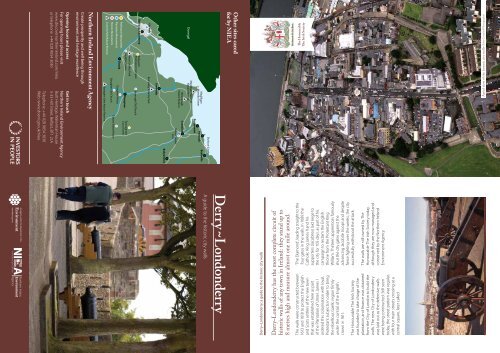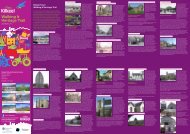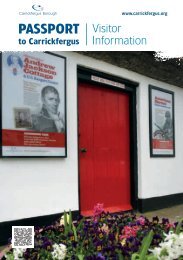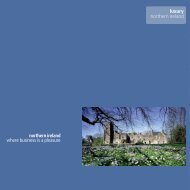Download A Guide to the Historic City Walls of Derry~Londonderry
Download A Guide to the Historic City Walls of Derry~Londonderry
Download A Guide to the Historic City Walls of Derry~Londonderry
- No tags were found...
Create successful ePaper yourself
Turn your PDF publications into a flip-book with our unique Google optimized e-Paper software.
<strong>Derry~Londonderry</strong>: a guide <strong>to</strong> <strong>the</strong> his<strong>to</strong>ric city walls<strong>Derry~Londonderry</strong> has <strong>the</strong> most complete circuit <strong>of</strong>his<strong>to</strong>ric walls <strong>of</strong> any <strong>to</strong>wn in Ireland: <strong>the</strong>y stand up <strong>to</strong>8 metres high and measure almost one mile around.The walls were constructed between1613 and 1618 <strong>to</strong> protect <strong>the</strong> Englishand Scots settlers <strong>of</strong> <strong>the</strong> new <strong>to</strong>wnthat was established here as par<strong>to</strong>f <strong>the</strong> Plantation <strong>of</strong> Ulster. James Iordered this colonisation with loyal,Protestant subjects in order <strong>to</strong> bring<strong>the</strong> rebellious Gaelic region firmlyunder <strong>the</strong> control <strong>of</strong> <strong>the</strong> Englishcrown in 1611.The Honourable The Irish Societywas founded <strong>to</strong> take charge <strong>of</strong> <strong>the</strong>plantation, and finance was obtainedfrom <strong>the</strong> <strong>City</strong> <strong>of</strong> London <strong>to</strong> build <strong>the</strong>walls. The new <strong>City</strong> <strong>of</strong> Londonderrywas laid out as <strong>the</strong> defensive wallswere being constructed. Still seen<strong>to</strong>day, <strong>the</strong> street pattern was regular,with four main streets crossing at acentral square, later called‘The Diamond’, leading straight <strong>to</strong> <strong>the</strong>four gates in <strong>the</strong> walls. In 1689 <strong>the</strong>Catholic King James II and hissupporters (Jacobites) laid siege <strong>to</strong><strong>the</strong> city for 105 days, as part <strong>of</strong> hiscampaign <strong>to</strong> reclaim <strong>the</strong> Englishthrone from <strong>the</strong> Protestant KingWilliam. Thirteen apprentices famouslyshut <strong>the</strong> city gates against <strong>the</strong>advancing Jacobite troops and despitefierce fighting over <strong>the</strong> weeks, <strong>the</strong> citysuccessfully withs<strong>to</strong>od <strong>the</strong> attack.The walls are still owned by TheHonourable The Irish Society <strong>to</strong>day,although <strong>the</strong>y are now managed andconserved by <strong>the</strong> Nor<strong>the</strong>rn IrelandEnvironment Agency.The HonourableThe Irish SocietyAerial view <strong>of</strong> <strong>the</strong> his<strong>to</strong>ric city walls (Esler Crawford Pho<strong>to</strong>graphy)O<strong>the</strong>r sites caredfor by NIEA<strong>Derry~Londonderry</strong>DonegalMagilliganMartello TowerMagilligan NationalNature ReservePortrushPortstewartDunluce CastleBushmillsA guide <strong>to</strong> <strong>the</strong> his<strong>to</strong>ric city wallsBinevenaghNature ReserveColeraineMount SandelFortBallymoneyLimavady<strong>City</strong> <strong>Walls</strong>Roe Valley Country Park<strong>Derry~Londonderry</strong>BallygrollPrehis<strong>to</strong>ric ComplexBovevagh Old ChruchNess Country ParkBrackfield BawnPrehis<strong>to</strong>ric MonumentsClaudyPlantation MonumentsHis<strong>to</strong>ric MonumentsCountry Park/Nature ReserveDungivenDungiven PrioryBanagher Old ChurchBanagher Glen Nature ReserveTamnyrankinCourt TombTirkane Sweat HouseNor<strong>the</strong>rn Ireland Environment AgencyCreate prosperity and well being throughenvironment and heritage excellenceOpening hours and accessFor opening hours please visitwww.discovernor<strong>the</strong>rnireland.com/nieaor telephone +44 028 9054 3030Get in <strong>to</strong>uchNor<strong>the</strong>rn Ireland Environment AgencyBuilt Heritage, Waterman House5-33 Hill Street, Belfast, BT1 2LATelephone: +44 028 9054 3030Web: www.doeni.gov.uk/niea©NITB
1A Tour <strong>of</strong> <strong>the</strong> <strong>City</strong> <strong>Walls</strong>11The BogsideD10Magazine GateThis gate was built in 1865.Recently res<strong>to</strong>red cannon aremounted on replicas <strong>of</strong> mid-17th-century block carriages.The two cannon closest <strong>to</strong>Shipquay Gate bear <strong>the</strong> Tudorrose-and-crown emblem; onehas a date stamp <strong>of</strong> 1590.9Free Derry Corner120 metres1008The Fountain1413Bishop Street WithinThe best way <strong>to</strong> experience <strong>the</strong>se magnificent 400 yearold walls is by taking a stroll along <strong>the</strong> rampart walkway.To really appreciate <strong>the</strong>m, however, you should also usesome <strong>of</strong> <strong>the</strong> many access steps or ramps <strong>to</strong> come downand walk around <strong>the</strong> walls at ground level. We have used<strong>the</strong> current names <strong>of</strong> gates and bastions around <strong>the</strong> walls,but many <strong>of</strong> <strong>the</strong>m had earlier names.2Shipquay GateThis was one <strong>of</strong> <strong>the</strong> four originalgates in<strong>to</strong> <strong>the</strong> 17th-century city,although <strong>the</strong> structure we seehere <strong>to</strong>day was built in 1805.The River Foyle originally flowedup <strong>to</strong> <strong>the</strong> foot <strong>of</strong> <strong>the</strong> city wallshere and ships that enteredLough Foyle moored closeby for people and goods <strong>to</strong>be unloaded.37Water BastionMost <strong>of</strong> this bastion wasdemolished around 1850and all that now remains is asmall platform. Outside <strong>the</strong>Millennium Forum <strong>the</strong>atre isa sculpture by <strong>the</strong> artistAn<strong>to</strong>ny Gormley.E156C16 17The Diamond45New Gate Bastion4Two demi-culverin cannon aremounted on replicas <strong>of</strong> 17thcenturyfield carriages. Fourembrasures (openings) wouldhave allowed artillery <strong>to</strong> providecovering fire along <strong>the</strong> adjacentwall face.5Ferryquay Street Butcher StreetGSite <strong>of</strong>Gunner’sBastionFerryquay GateSt Eugene’sCa<strong>the</strong>dral18Shipquay StreetFerryquay Gate is located on <strong>the</strong>site <strong>of</strong> one <strong>of</strong> <strong>the</strong> four originalgates. It probably led down <strong>to</strong><strong>the</strong> ferry and later, <strong>to</strong> <strong>the</strong> firstcity bridge. It was this gate tha<strong>to</strong>n December 7th 1688 wasclosed by <strong>the</strong> 13 apprentices <strong>to</strong>prevent Jacobite troops entering<strong>the</strong> city, leading <strong>to</strong> <strong>the</strong> siege <strong>of</strong>1689. The present gate was builtin 1866, and <strong>the</strong> carved headsrepresent <strong>the</strong> Revs GeorgeWalker and James Gordon.619Artillery BastionWithin Artillery Bastion are twocannon. The first is an Englishsaker with a <strong>City</strong> <strong>of</strong> Londonshield on it, one <strong>of</strong> a batch sentby <strong>the</strong> <strong>City</strong> in 1620. The secondis a demi-culverin sent <strong>to</strong> <strong>the</strong>city in 1642 by <strong>the</strong> LondonSalters Company, one <strong>of</strong> a group<strong>of</strong> 15 gifted by <strong>the</strong> LondonCompanies <strong>to</strong> streng<strong>the</strong>n<strong>the</strong> defences.7BSt Columb’s Ca<strong>the</strong>dralSt Columb’s Ca<strong>the</strong>dral was builtbetween 1628 and 1633. During<strong>the</strong> 1689 siege <strong>the</strong> lead from <strong>the</strong>spire was used for artillery, andtwo cannon were mounted on<strong>the</strong> <strong>to</strong>wer for defence. As youwalk along <strong>the</strong> ramparts, note<strong>the</strong> sentry box. A firing platformfor musketeers (banquette) mayhave been positioned here.220Site <strong>of</strong>1 Coward’sBastionBased upon ©Crown Copyrightand database right 2013 EMOU 206.2New Gate3Site <strong>of</strong>Water BastionShipquay SquareNew Gate was first opened in1787 and was later replaced by<strong>the</strong> present gate in 1866.8FA9Church BastionIt was from Church Bastion thatKing James II was fired uponas he approached <strong>the</strong> city onApril 18th 1689, when <strong>the</strong> siegebegan in earnest. In <strong>the</strong> bastionyou can see two demi-culverincannon. Along <strong>the</strong> outer wallface is a small gateway, knownas a ‘sallyport’. Tradition hasit that this gateway was usedduring <strong>the</strong> siege, and that itleads in<strong>to</strong> St Columb’s Ca<strong>the</strong>dral.10Bishop’s GateBishop’s Gate was one <strong>of</strong> <strong>the</strong>four original entrances <strong>to</strong><strong>the</strong> city. The current gatewas erected in 1789 incommemoration <strong>of</strong> <strong>the</strong> 1689siege. The carved keys<strong>to</strong>nesrepresent <strong>the</strong> Rivers Boyneand Foyle.11Double BastionThe Double Bastion holds twodemi-culverin cannon, one <strong>of</strong>which is <strong>the</strong> famous RoaringMeg. There is a fine panoramicview over <strong>the</strong> Bogside and <strong>the</strong>slopes above, where Jacobiteguns were positioned during<strong>the</strong> 1689 siege.12Grand ParadeGrand Parade was used asa promenade in <strong>the</strong> 19thcentury. The sycamore treescommemorate <strong>the</strong> 13apprentices who closed <strong>the</strong>gates on King James’ soldiersduring <strong>the</strong> 1689 siege: <strong>the</strong> frui<strong>to</strong>f <strong>the</strong> sycamore tree resemblesa bunch <strong>of</strong> keys; symbolic <strong>of</strong><strong>the</strong> locked gates. One <strong>of</strong> <strong>the</strong>cannon sent over in 1620bears a <strong>City</strong> <strong>of</strong> London shield.13St Augustine’s ChurchIt is likely that this church wasbuilt upon <strong>the</strong> site <strong>of</strong> a ruinedmedieval church known as <strong>the</strong>Dubh Regles (Black Church).14Royal BastionThe Governor Walker memorialpillar was erected in 1828 <strong>to</strong>commemorate <strong>the</strong> shutting <strong>of</strong><strong>the</strong> city gates by <strong>the</strong> ApprenticeBoys <strong>of</strong> Derry during <strong>the</strong>1689 siege. The pillar wassurmounted by a statue <strong>of</strong> <strong>the</strong>Rev George Walker, Governor <strong>of</strong><strong>the</strong> city throughout <strong>the</strong> siege.It was blown up in 1973.There are also two late-18thcentury6-pounder cannonwithin <strong>the</strong> bastion.15The PlatformA long rectangular gun platformprotrudes out from <strong>the</strong> wallshere. Just opposite <strong>the</strong> Platformstands <strong>the</strong> Memorial Hall <strong>of</strong> <strong>the</strong>Apprentice Boys <strong>of</strong> Derry, andnearby is First Derry PresbyterianChurch, built before 1780 on <strong>the</strong>site <strong>of</strong> an earlier church foundedin 1690. The pediment wasadded in 1828.16Butcher’s GateButcher’s Gate was one <strong>of</strong> <strong>the</strong>four original city gates, but <strong>the</strong>structure you see here <strong>to</strong>daywas rebuilt in 1810.17Gunner’s BastionNot far past Butcher’s Gatewas a demi-bastion, knownas <strong>the</strong> Gunner’s Bastion. It wasremoved sometime between1843 and 1873.18Castle GateCastle Gate is <strong>the</strong> smallest andone <strong>of</strong> <strong>the</strong> least elaborate <strong>of</strong><strong>the</strong> city’s gates. It was openedthrough <strong>the</strong> walls in 1802.19Hangman’s BastionHangman’s Bastion <strong>to</strong>ok itsname from an incident during<strong>the</strong> 1689 siege when a man,trying <strong>to</strong> escape over <strong>the</strong>walls, got caught in <strong>the</strong> ropehe was using and almosthanged. Fur<strong>the</strong>r along, <strong>the</strong> wallkinks outwards, probably <strong>to</strong>incorporate <strong>the</strong> late medievalO’Donnell <strong>to</strong>wer house whichonce s<strong>to</strong>od here.20Coward’s BastionAt <strong>the</strong> corner was <strong>the</strong> last <strong>of</strong><strong>the</strong> bastions, removed during<strong>the</strong> first half <strong>of</strong> <strong>the</strong> 19th century.This area was attacked leastduring <strong>the</strong> 1689 siege and sowas a popular posting for somemembers <strong>of</strong> <strong>the</strong> garrison, giving<strong>the</strong> bastion its name.©NITBO<strong>the</strong>r places <strong>of</strong> interestclose <strong>to</strong> <strong>the</strong> city wallsA GuildhallB Millennium ForumC PlayhouseVerbal Arts CentreE Apprentice Boys Memorial HallF Tower MuseumG Diamond War MemorialTo enhance your <strong>to</strong>ur youcan also take advantage<strong>of</strong> <strong>the</strong> free apps that areavailable <strong>to</strong> download,filled with unique featuresand his<strong>to</strong>rical images.Walk <strong>the</strong> <strong>Walls</strong>Blending CGI, videos, pho<strong>to</strong>sand 3D animations, this appprovides a unique guide <strong>to</strong> <strong>the</strong>his<strong>to</strong>ry <strong>of</strong> <strong>the</strong> city, ‘Before andAfter’ visualisations show howparts <strong>of</strong> <strong>the</strong> walls might haveoriginally looked, while a pho<strong>to</strong>library displays pho<strong>to</strong>graphs,illustrations and his<strong>to</strong>rical maps<strong>of</strong> each location.Siege <strong>of</strong> DerryThis app uses contemporary,real-life accounts and reactions<strong>of</strong> <strong>to</strong>wnspeople <strong>to</strong> bring <strong>the</strong>1689 siege <strong>to</strong> life. Survive <strong>the</strong>siege as a Jacobite spy and listen<strong>to</strong> accounts <strong>of</strong> <strong>the</strong> siege as youwalk around <strong>the</strong> walls.These Apps can be downloadedfree at <strong>the</strong> Google Play, Android orApple App s<strong>to</strong>res or alternativelyfrom discovernor<strong>the</strong>rnireland.comThis his<strong>to</strong>ric city and itsimpressive walls have along and varied his<strong>to</strong>ry.This is celebrated in abooklet published by<strong>the</strong> NIEA.<strong>Derry~Londonderry</strong>A His<strong>to</strong>ry and Tour<strong>of</strong> <strong>the</strong> <strong>City</strong> <strong>Walls</strong>Incorporating a moreindepth version <strong>of</strong> this<strong>to</strong>ur and a brief his<strong>to</strong>ry<strong>of</strong> <strong>the</strong> settlement <strong>of</strong><strong>Derry~Londonderry</strong>.The booklet is available<strong>to</strong> purchase at variouslocations around <strong>the</strong> city.
















